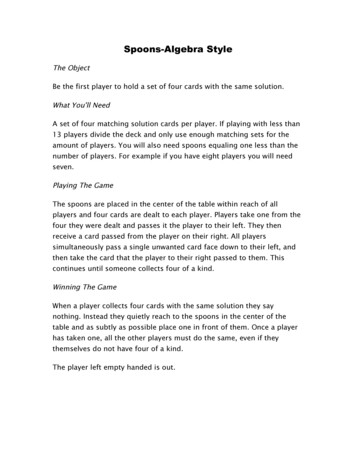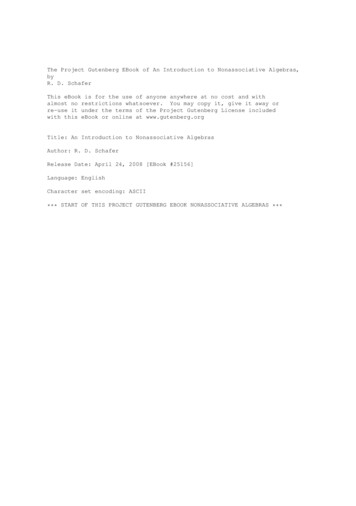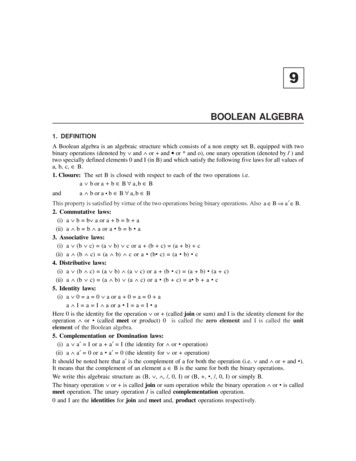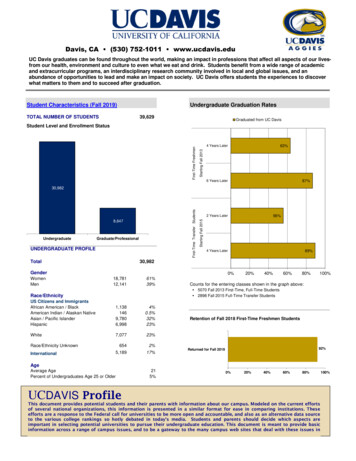
Transcription
Spoons-Algebra StyleThe ObjectBe the first player to hold a set of four cards with the same solution.What You'll NeedA set of four matching solution cards per player. If playing with less than13 players divide the deck and only use enough matching sets for theamount of players. You will also need spoons equaling one less than thenumber of players. For example if you have eight players you will needseven.Playing The GameThe spoons are placed in the center of the table within reach of allplayers and four cards are dealt to each player. Players take one from thefour they were dealt and passes it the player to their left. They thenreceive a card passed from the player on their right. All playerssimultaneously pass a single unwanted card face down to their left, andthen take the card that the player to their right passed to them. Thiscontinues until someone collects four of a kind.Winning The GameWhen a player collects four cards with the same solution they saynothing. Instead they quietly reach to the spoons in the center of thetable and as subtly as possible place one in front of them. Once a playerhas taken one, all the other players must do the same, even if theythemselves do not have four of a kind.The player left empty handed is out.
Geometry BingoThe ObjectGet a BINGO!What You'll NeedA bingo card per personA Question sheet or PowerPointPlaying The GameStudents choose where to put their “answers” on their card. Once theircards are full, the host asks questions and students mark the answers ontheir cards.Winning The GameCross off all the squares in one row or column before your classmates.
GEOMETRY BINGO KEYQuestions1. The sum of exterior angles, one at each vertex,of a nonagon, in degrees.2. The sum of complementary angles, in degrees.3. In a 45-45-90 triangle, if a leg is 5, what is thehypotenuse?4. In a regular polygon, all sides are ? .5. If two triangles are similar, corresponding anglesare ? .6. In a right triangle, if a 15, b 20, then c ? .7. If c2 a2 b2, what type of triangle is this?8. In a 30-60-90 triangle, if the hypotenuse is 12,the short leg is ? .9. A quadrilateral with exactly one pair of oppositesides parallel.10. Sum of the interior angles of a pentagon, in degrees.11. The sum of supplementary angles, in degrees.12. Adjacent angles share a side and a(n) .13. The measure of an interior angle of a regularHexagon, in degrees.14. If c2 a2 b2, what type of triangle is this?15. A quadrilateral with congruent sides andcongruent angles is a(n) ? .16. In a right triangle, ? is a congruence property.17. The sum of the interior angles of a dodecagon, indegrees.18. The area of a triangle with b 14”, h 10” is? sq. in.19. A quadrilateral with one pair of opposite sidescongruent and parallel.20. Something we accept that is true (cannot prove).21. In this quadrilateral, one pair of opposite anglesis congruent.22. If ABCD is a parallelogram, and the m A 45o,what is the m B, in degrees?23. If corresponding sides of two triangles areproportional, the triangles are ? .24. A conclusion based on facts is ? reasoning.25. If QRST is a parallelogram, and the m S 140o,what is the m Q, in degrees?Answers360905 kite135TheoremsimilarDeductive140
Factoring BingoObjective:Correctly factor polynomials and be the first to get five factors in a row.What you will need:One blank BINGO card per student (or pair of students)One list of possible factors per pair or groupWork space (copied on back of BINGO card)Some kind of marker – crayon, beans, M&Ms, etc.List of equations to be factoredPlaying the game:This activity is designed to give students practice in factoring polynomials. You can chooseequations based on patterns or concepts (common factors) that you want them to focus on, orchoose the equations randomly.Each student will create their own BINGO card (use colored marked to avoid changes) using thefactors from the factor list – one factor per box. Each factor can only be used once.Start the game by writing an equation on the board and have students factor it. They must keeptheir work to show that they factored the equation. If students have those factors on their board,they can cover them up with their markers. (If you are using beans as markers, the work needs tobe on a separate page.) Continue writing equations on the board until a student calls BINGO.Check their work to confirm correct factoring. Continue until you have a few more BINGOs orcontinue to “black out.”
Factor Bingo Equations1. 2x 2y2. x2 – 4x 33. x2 x – 204. x2 – 6xy 5y25. 6x2 13x 66. 6x2 – 5x – 47. 2x2 – 5x 28. x2 x – 69. x2 – 2510. 4x 1211. 4x2 – 912. 2x2 6x 413. 3x2 4x14. 9x2 12x15. 9x2 – 4916. 2x2 30x17. x2 – 8x 1218. x2 11x 1819. x2 2xy – 15y220. 4x2 – 11x – 321. 8x2 – 2x – 322. 3x – 923. x2 2x 424. x2 12x 3625. 2x2 – 9x - 3526. 9x2 – 127. 5x – 3028. 5x2 – 15x29. 4x2 – 1630. 2x2 – 22(x y)(x – 3)(x – 1)(x 5)(x – 4)(x – 5y)(x – y)(2x 3)(3x 2)(3x – 4)(2x 1)(2x – 1)(x – 2)(x 3)(x – 2)(x 5)(x – 5)4(x 3)(2x – 3)(2x 3)2(x 1)(x 2)x(3x 4)3x(3x 4)(3x – 7)(3x 7)2x(x 15)(x – 6)(x – 2)(x 9)(x 2)(x 5y)(x – 3y)(4x 1)(x – 3)(2x 1)(4x – 3)3(x – 3)(x 2)(x 2)(x 6)(x 6)(2x 5)(x – 7)(3x 1)(3x – 1)5(x – 6)5x(x – 3)4(x – 2)(x 2)(2x – 2)(x 1)
Factors2345x2x3x4x5x(x y)(x – y)(x – 1)(x – 2)(x – 3)(x – 4)(x – 5)(x – 6)(x – 7)(x – 5y)(x – 3y)(x 5y)(2x 1)(2x – 1)(2x 3)(2x – 3)(2x 5)(3x 1)(3x – 1)(3x 2)(3x 4)(3x – 4)(3x 7)(3x – 7)(4x 1)(4x – 3)(x 1)(x 2)(x 3)(x 5)(x 6)(x 9)(x 15)Factors2345x2x3x4x5x(x y)(x – y)(x – 1)(x – 2)(x – 3)(x – 4)(x – 5)(x – 6)(x – 7)(x – 5y)(x – 3y)(x 5y)(2x 1)(2x – 1)(2x 3)(2x – 3)(2x 5)(3x 1)(3x – 1)
(3x 2)(3x 4)(3x – 4)(3x 7)(3x – 7)(4x 1)(4x – 3)(x 1)(x 2)(x 3)(x 5)(x 6)(x 9)(x 15)
B I N G OFREESPACE
Factoring PuzzlesObjective:Match correct factors to quadratic equations.What you will need:Factor puzzle piecesPage to glue the puzzle togetherPage to show work for factoringSolution (for teacher!)Playing the game:Have students cut apart the puzzle pieces. Match factors and equations and put thepuzzle together
My Factoring PuzzleName:
Factoring Puzzle ICarefully cut apart the puzzle squares. Arrange them by matching correct factors and equations.Glue the final arrangement to your My Factoring Puzzle page. Once the puzzle is complete changethe numbers in the middle of the squares into letters for a special message. Show all your work ona separate piece of paper.
Factoring Puzzle IICarefully cut apart the puzzle squares. Arrange them by matching correct factors and equations.Glue the final arrangement to your My Factoring Puzzle page. Show all your work on a separatepiece of paper.
Factoring Puzzle IIICarefully cut apart the puzzle squares. Arrange them by matching correct factors and equations.Glue the final arrangement to your My Factoring Puzzle page. Show all your work on a separatepiece of paper. The triangles will form a hexagon.Section 1
Section 2
Section 3
Polynomial Puzzle SquaresThe ObjectMatch the expressions to place all the pieces into a square.Alternative (simpler version):Place them in a line (domino style)What You'll NeedA puzzle square tile set (envelope)Playing The GameMatch the expressions on adjacent sides to put the puzzle back together.All adjacent expressions should be equivalent.Winning The GameGetting all the pieces in the right place to complete the puzzle.
(4x – 1)2(3x-2)2x2 7x -189x2 – 12x 4x2 6x - 16(x – 3)(x 6)6x2 41x 30(x 6)(6x 5)(5x – 4)(5x 4)(x – 2)(x 8)(5x – 4)2(x 4)(x – 4)25x2 - 16(x – 4)(x -6)x2 3x - 18(x – 2)(x – 9)(x 3)2x2 – 14x 24x2 – 10x 24(x 1)(x – 1)(3x 2)(2x 3)233)6x2 13x 6x2 6x 9(6x 1)(x – 2)x2 - 16x2 - 4x - 12(x 2)(x – 6)(x 2)(x – 2)(2x–5)(2x 5)(x 3)(x – 3)(4x – 1)(4x 1)(x – 4)(x – 3)(x – 4)2x2 3x - 10(x 3)(x – 4)(3x – 2)(3x 2))(3x – 1)(x 1)(2x 5)2x2 – 8x 16x2 16(2x–5)(2x 1)9x2 - 4x2 – x - 123x2 2x - 14x2 20x 25x2 96x2 – x - 2(7x – 5)(x-2)4x2 x - 57x2 – 19x 10(x 3)(x 1)25x2 20x 4x2 – 2x - 15x2 –6x - 16x2 4x 3(4x 5)(x – 1)x2 – 7x 12(x 3)(x – 5)16x2 - 1(x 2)(x – 8)x2 - 9(x 2)(x 5)4x2 - 25x2 - 15
SPLAT!The ObjectBe the team to smack the correct answer with the swatter the most times.What You'll NeedFly swattersAnswer cardsQuestion ListPlaying The GameSplit into the number of teams equal to the number of swatters you have.Team members take turns being the “swatter”. Read or place a questionon the overhead, doc camera or projector. Swatters search the room (withhelp form their teammates) and try to be the first to swat the correctanswer. Point can be awarded for 1st, 2nd and 3rd or just for first.Winning The GameThe team with the most number of points at the end of the game wins.
11
11
11
1
11
1
Factoring Puzzle I Carefully cut apart the puzzle squares. Arrange them by matching correct factors and equations. Glue the final arrangement to your My Factoring Puzzle page. Once the puzzle is complete change the numbers in the middle of the squares into letters for a special message. Show all your work on a separate piece of paper.











